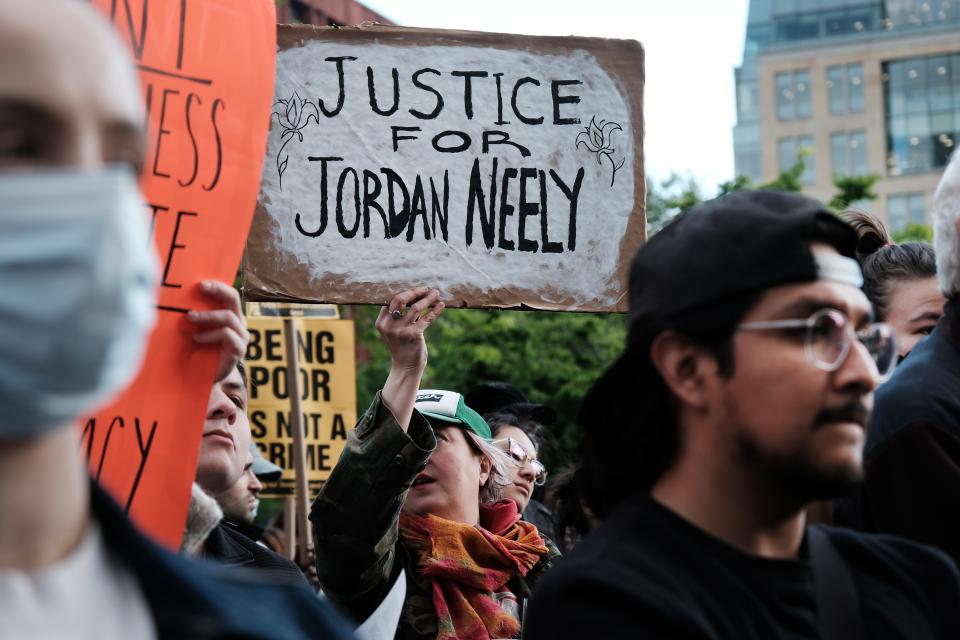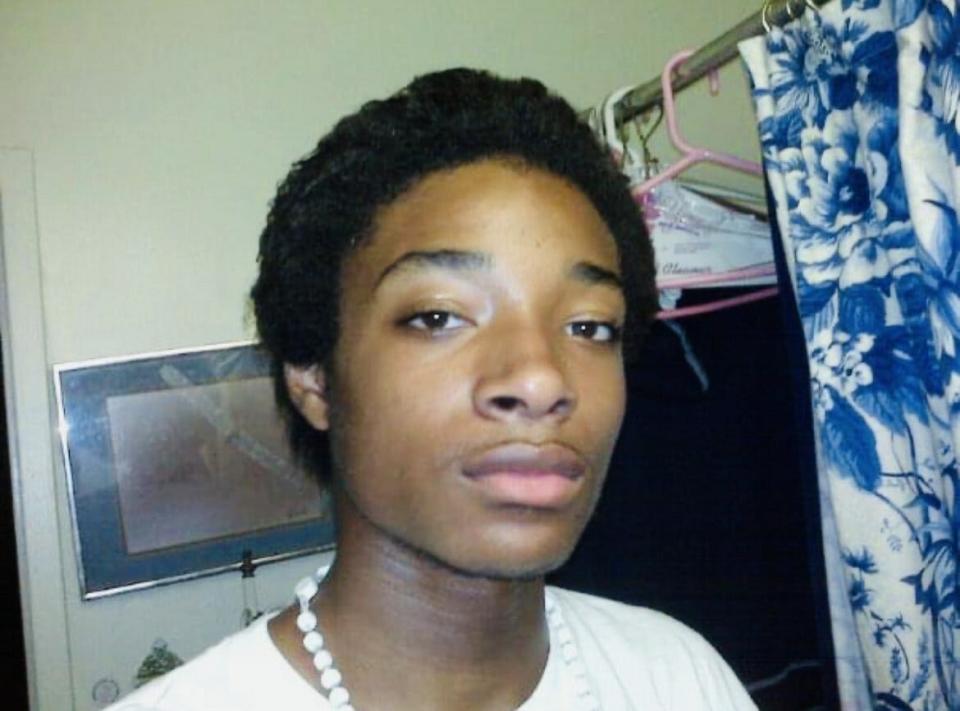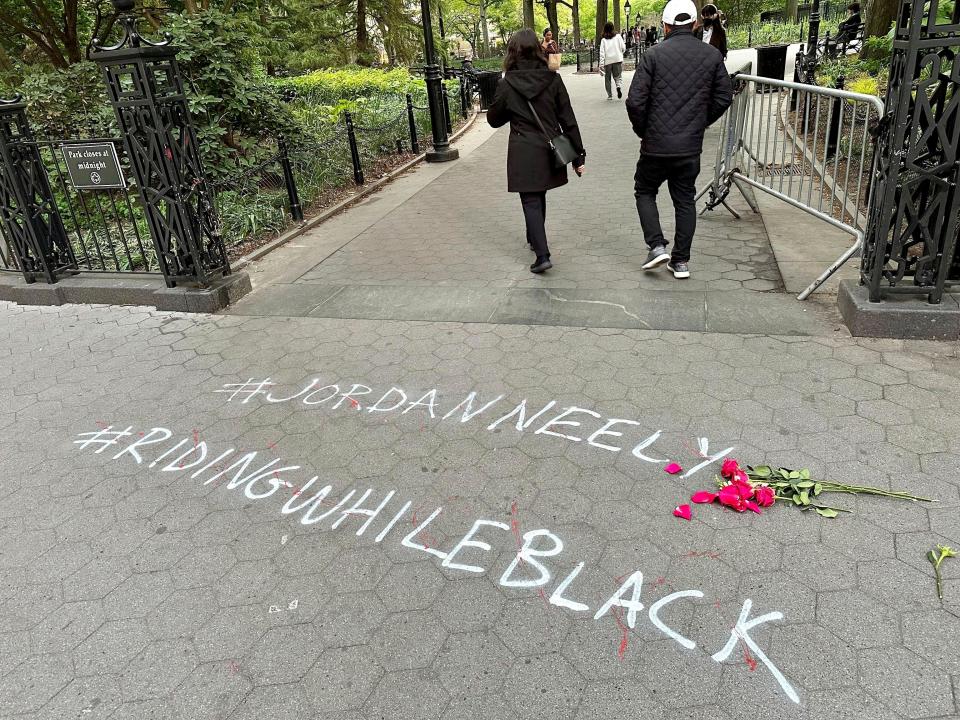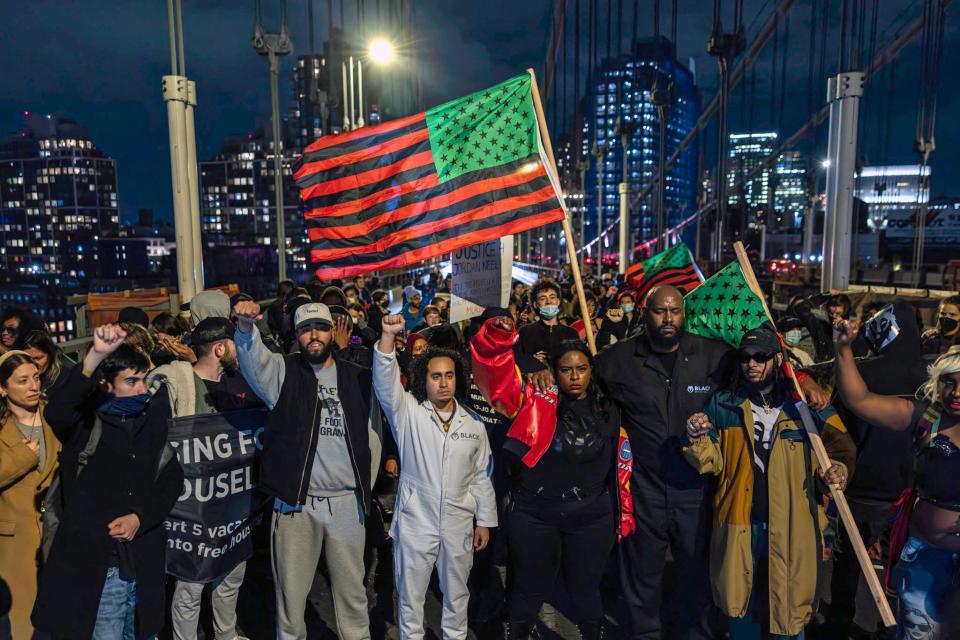NYC subway chokehold: Why Jordan Neely's death is the next American bonfire | Mike Kelly
Maybe you know this scene.
You’re sitting on a New York City subway car. The train squeals to a halt at a station. The doors slide open and a homeless man walks on, yelling to no one in particular that he is hungry and needs money.
You can feel the subway car’s passengers collectively freeze. No one speaks to the man. No one makes eye contact. But everyone is aware of him.
The man walks the length of the subway car. A few people hand him some coins. You hope he doesn’t stop to speak to you. At the next stop, he leaves, cursing and yelling incoherently.
For several years, as the COVID-19 pandemic worsened and homelessness grew exponentially with desperate and disheveled men suffering from mental illness and various addictions, this kind of scene has been a new normal in New York City’s subway system.
But last week, this so-called “normal” took on a new cultural and social twist.
A passenger on an afternoon F train heading to SoHo confronted a homeless man, Jordan Neely, 30, who had been shouting at others in a crowded subway car that he was hungry. The passenger, Daniel J. Penny, 24, a former U.S. Marine, wrapped his arms around Neely’s neck with a military-style chokehold. Penny pulled Neely to the subway car floor and held him there as two other men struggled to hold down his flailing legs.
Minutes passed. Neely fell limp, unconscious. Paramedics were unable to revive him. Later, at a hospital, Neely was pronounced dead.
Understandably, the tragic death of a hungry, homeless man is upsetting. While seemingly scary and yelling in a disturbing manner, Neely, a chronic drug abuser with a long record of arrests, was nevertheless crying out for help in the final minutes of his life.

His death has evolved into yet another bonfire moment for America — one of those tragedies in which race, politics and crime all collide in a whirlpool of chaos. Penny will face a charge of second-degree manslaughter in Neely's death and was expected in Manhattan Criminal Court Friday. But in examining this event, which lens do we choose that offers the best perspective?
Do we take on the view of Rep. Alexandria Ocasio-Cortez, the progressive Democratic firebrand from Queens, who proclaimed that “Jordan Neely was murdered”? Do we accept the view that the Marine-trained Penny resorted to a deadly chokehold in self-defense? Or, to put it another way, was Penny's action necessary to stop Neely from hurting someone?
Finally, do we assume, as the Rev. Al Sharpton and other civil rights activists claim, that this event needs to be framed by race — that this is yet another story of a Black man dying at the hands of a white man, with a criminal justice system that is far too slow to raise basic questions of accountability?
The problem here is that all three viewpoints offer some measure of credibility and insight.
More: Potential charges in NYC chokehold death of Jordan Neely may hinge on 'reasonableness'
Neely needed help — not a chokehold
Neely’s death may not fit the legal definition of murder, but what makes it so troubling is that it should never have happened. A mentally challenged homeless man yelling for food is not a capital offense. Neely needed help, not a trip to the morgue.

But who was Neely, actually? Asking that question requires another lens to view this tragedy.
Neely has been described as a gentle soul who earned money in street performances in the Times Square area in which he impersonated pop star Michael Jackson. Tall, with a thin face and a wiry physique like Jackson’s, Neely sometimes wore a red drum major’s jacket similar to one that Jackson popularized during his "Thriller" heyday.
But there is more to this story than just Neely being hungry and trying to eke out a living strutting on a sidewalk in ways that made people recall Michael Jackson. Neely abused drugs. He had also been arrested more than three dozen times.
Most of his arrests involved non-violent crimes such as trespassing or jumping the turnstiles in the New York subway system without paying. But Neely had been arrested at least four times for allegedly randomly punching people. Two of those assaults took place in the subway system.
A 'young man in real crisis': Who was Jordan Neely, the New York subway victim?
In November 2021, Neely punched a 67-year-old woman on New York’s Lower East Side.
Neely, who also had been abusing an especially potent form of synthetic marijuana, was arrested and tossed in jail for 15 months. In early February 2023, he pleaded guilty to assault.
In return for the guilty plea, a judge cut Neely a break. If he agreed to move into a drug treatment facility in the Bronx and remained drug-free for 15 months, his felony assault conviction for punching the woman would be reduced.
A court transcript of that hearing, unearthed by The New York Times, brimmed with hope for Neely.
“This is a wonderful opportunity to turn things around, and we’re glad to give it to you,” Mary Weisgerber, a prosecutor in the case, told Neely.
“Thank you so much,” he replied.

Neely checked into the Bronx treatment facility. But 13 days later, he abruptly left. The judge who had cut him a break signed a warrant for his arrest.
Police never caught up with Neely, even though he was well-known as one of the city’s most desperate street people and had been treated by New York's Intensive Mobile Treatment teams. As Neely's mental state seemed to worsen dramatically in recent months, he somehow managed to elude the safety net set up by government to save him.
The Times reported that a homeless outreach worker spotted Neely in March. But without checking his criminal record, which would have revealed the arrest warrant, the outreach worker merely arranged for Neely to get a ride back to the Bronx. Did Neely make the trip? Who knows? The narrative of his life is filled with dozens of cracks that he fell through.
A month later, the Times reported that another outreach worker found Neely in an especially troubling state on a subway car at the last stop in Coney Island. Neely urinated in front of the worker, who then summoned police.
The officers did not run a criminal check on Neely. So once again, he escaped being picked up on the arrest warrant. The officers merely kicked Neely off the train. Where did he go? Who knows?
A week later, the Times reported that yet another outreach worker spotted Neely and reported that he seemed more aggressive and incoherent. “He could be a harm to others or himself if left untreated,” the worker wrote.
No one intervened. We don't know why.
Two weeks later, Neely died on the F train from Daniel Penny’s chokehold.
'We've got a deep problem': Jordan Neely NYC subway chokehold death sparks outcry
Can't we do better for our most vulnerable?
Did Penny plan to kill Neely? Was the chokehold an abuse of force? Or was it necessary to hold down a seemingly aggressive homeless man?
Penny’s attorneys released a statement that offers yet another perspective on this tragedy.
“When Mr. Neely began aggressively threatening Daniel Penny and the other passengers, Daniel, with the help of others, acted to protect themselves, until help arrived,” the statement said. “Daniel never intended to harm Mr. Neely and could not have foreseen his untimely death.”

But what about race?
If Daniel Penny had been Black, would Sharpton have intervened? Asking such a question is, in itself, politically incorrect. But as the narrative of this bonfire moment involving Neely and Penny unfolds, it’s impossible to ignore the fact that the victim is Black and the passenger who felt threatened is white.
The problem here is that such racial delineations don’t offer a complete portrait of the level of fear on that subway car. More than a year ago, an Asian woman was pushed to her death on the subway tracks by a Black homeless man with a long history of mental illness. Civil rights activists did not chant "no justice, no peace" in her memory, however.
Police said witnesses told them Neely was behaving in a “hostile and erratic manner.” But it needs to be said that Neely did not attack anyone on the F train.
But does that matter? Do frightened subway passengers have to wait until they are punched before trying to defend themselves?
One passenger on the F train, Juan Alberto Vazquez, who recorded Neely’s chokehold death on a cellphone camera, told the Washington Post that Neely yelled: “I don’t have food, I don’t have a drink, I’m fed up. I don’t mind going to jail and getting life in prison. I’m ready to die.”
How should ordinary people respond to such a statement — and its aggressive, angry tone? If Penny merely told Jordan Neely to "shut up" or "get lost," would Neely have become more aggressive and threatening?
What is the right response, anyway?
Vazquez said Penny held Neely for three minutes in the chokehold. Along with two other male passengers, Penny then held Neely on the floor of the subway car for another 15 minutes before police and paramedics arrived.
This is no way to treat disadvantaged people who suffer from mental illness. But at the same time, it’s not acceptable to allow homeless people with mental problems to yell at subway riders as they panhandle for loose change.
The deeper problem here is perhaps the hardest to confront.
America, for all its technological know-how, still can’t find a way to care for some of its most vulnerable citizens.
Instead, we let them ride our subways.
Mike Kelly is an award-winning columnist for the USA TODAY Network as well as the author of three critically acclaimed non-fiction books and a podcast and documentary film producer. To get unlimited access to his insightful thoughts on how we live life in the northeast, please subscribe or activate your digital account today.
Email: kellym@northjersey.com
This article originally appeared on NorthJersey.com: Jordan Neely: NYC subway chokehold death our new outrage
